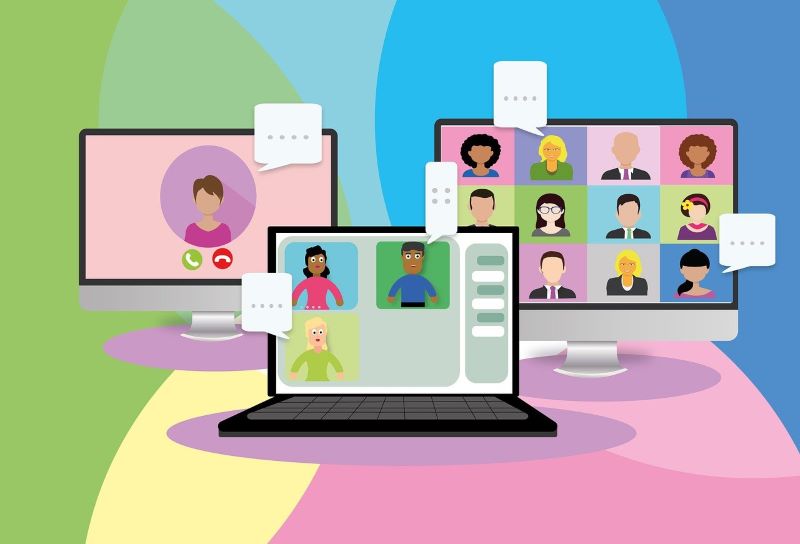In 2024, the landscape of professional training is evolving at lightning speed. Technological advancements are redefining how we learn, offering unprecedented opportunities for training, skill enhancement, and staying competitive in a constantly changing world. It is crucial for us, as businesses and professionals, to understand and adopt these new training methods.
In this article, we dive deep into the trends, from e-learning to virtual reality, microlearning, and personalization through artificial intelligence. Together, let’s analyze how these innovations are transforming learning and impacting the way we develop our skills for tomorrow.
Join us in this exploration of the approaches shaping the future of professional training and discover how you can integrate them to advance your organization.
The Rise of E-learning

A. Definition and Principles of E-learning
E-learning, or online learning, encompasses all training systems that use the internet to allow learners to acquire skills remotely. Since its inception, e-learning has radically changed how we access training. Whereas training was previously mostly conducted in-person, e-learning has introduced unprecedented flexibility, allowing everyone to train at their own pace, wherever they are.
The evolution of e-learning has accelerated with the advent of digital technologies. Today, this training mode integrates interactive multimedia content, live sessions (webinars), discussion forums, and online practical exercises. This transformation has made learning more accessible and inclusive, removing geographical barriers and offering training opportunities to millions worldwide.
The benefits of e-learning are numerous:
- Flexibility: Learners can follow courses according to their own schedule, adapting to their personal and professional obligations.
- Accessibility: With just an internet connection, training is accessible to a wide audience, regardless of location.
- Autonomy: E-learning encourages a proactive approach to learning, where learners can choose the modules that best suit their needs.
B. Innovative Platforms and Tools
The rise of e-learning has given birth to a multitude of platforms that reinvent the learning experience. These platforms no longer just deliver theoretical content; they integrate interactive tools that facilitate skill acquisition and make learning more engaging.
E-learning platforms in 2024:
- Platforms that continue to dominate the e-learning market by offering online courses from top universities worldwide. In 2024, they introduce even more personalized learning paths, integrating artificial intelligence to tailor content to the specific needs of each learner.
- Learning Management Systems (LMS) have become standards for businesses and educational institutions. They allow for the creation, distribution, and tracking of online training, with collaboration and gamification features.
- Tools that allow the creation of interactive and engaging content without requiring advanced technical skills. In 2024, they incorporate augmented reality features to further enrich the learning experience.
These tools and platforms in the e-learning domain make learning more dynamic and relevant for today’s learners.
C. Impact on Learners
The impact of e-learning on learners is considerable. One of the major benefits lies in the reduction of training-related costs. By eliminating travel, accommodation costs, and optimizing training time, e-learning offers a more economical alternative compared to traditional methods.
Another key aspect is the personalization of learning paths. Thanks to artificial intelligence and data analysis, e-learning platforms in 2024 can adapt content to the specific needs of each learner, maximizing training effectiveness. This personalization allows learners to focus on the skills they need to develop, while progressing at their own pace.
Finally, e-learning has proven effective in skill retention. Interactive content, regular quizzes, and integrated review modules on e-learning platforms promote better knowledge assimilation. The rise of e-learning in 2024 is a response to the growing need for more accessible, flexible, and personalized training, offering learners an enriching learning experience tailored to their individual requirements.
Virtual Reality (VR): A Revolutionary Immersion

A. Introduction to VR in Training
Virtual Reality (VR) is transforming the landscape of professional training by offering immersive and engaging learning experiences. VR creates three-dimensional environments where users can interact realistically, simulating real situations without leaving their physical space. This technology, once reserved for video games and entertainment, has rapidly integrated into the training domain due to its unique educational potential.
In 2024, VR integration in professional training is no longer just a trend but an essential component of many educational programs. Companies recognize VR’s potential to train employees more effectively, particularly in areas requiring complex technical or behavioral skills. VR allows for the simulation of dangerous or costly situations to reproduce in the real world, making learning both safe and economical.
B. Practical Applications
The practical applications of VR in training are numerous and varied, covering a wide range of industries. Here are some concrete examples:
Technical Training:
- Industry: In industrial sectors, VR is used to train workers to operate complex machinery or manage emergency situations. For example, a company can simulate a production environment with heavy machinery, allowing employees to practice handling this equipment without the risk of injury or material damage.
- Medicine:** VR is also widely used in the medical field to train surgeons and other healthcare professionals. Surgical simulations allow students and practitioners to perfect their skills without risk to patients.
Behavioral Training:
- Leadership and Management: VR offers interactive simulations where learners can practice their leadership skills in realistic scenarios, such as conflict management or decision-making under stress.
- Customer Service:** Companies use VR to train their staff in customer interactions. For example, an employee can practice handling a crisis situation with an unhappy customer, experiencing the situation as if it were real.
C. Advantages and Limitations
Advantages:
- Immersion: One of VR’s main strengths is its ability to immerse learners in realistic environments where they can interact with their training more meaningfully. This immersion enhances engagement and information retention.
- Safety: VR allows for the simulation of dangerous situations without exposing learners to real risks. This is particularly useful in fields like industry, where mistakes can have serious consequences.
- Practical Learning: By offering a realistic hands-on experience, VR helps learners acquire skills that can be applied immediately in their work. Simulations allow actions to be repeated until they are mastered without the costs associated with using real resources.
Limitations:
- Cost and Accessibility: Although VR equipment prices have decreased, the initial investment remains high for many companies, particularly small businesses. Moreover, creating VR training content can be expensive and time-consuming.
- Technical Limitations: Users may sometimes experience side effects such as headaches or nausea when using VR for extended periods. Additionally, the quality of the VR experience largely depends on the power of the equipment used, which can limit its widespread adoption.
- Acceptance and Adoption: Some employees may be reluctant to use VR due to unfamiliarity with the technology or concerns about its effectiveness compared to traditional methods.
Despite these challenges, virtual reality continues to gain ground in professional training. Its potential to offer immersive, safe, and effective learning experiences makes it a promising technology for the future of education and skill development.
Microlearning: The Power of Small Modules

A. What is Microlearning?
Microlearning is a pedagogical approach that divides learning into short, targeted, and easily digestible segments. Unlike traditional training, which can last several hours or days, microlearning offers training modules of just a few minutes, focusing on specific topics. These modules are designed to be quickly consumed, often via digital platforms, and are accessible at any time.
The concept of microlearning is based on the idea that learners retain information better when presented in small amounts and in an easy-to-digest format. By focusing on one skill or topic at a time, microlearning maximizes learning effectiveness while adapting to learners’ time constraints.
B. Benefits of Microlearning
Microlearning offers several advantages that make it an increasingly popular training method, particularly in continuing education and skill development in companies.
- Information Retention: Microlearning improves information retention through repetition and a focus on specific concepts. By breaking learning into small units, learners are more likely to remember and reuse the knowledge acquired.
- Flexibility: One of microlearning’s main attractions is its flexibility. Modules can be accessed at any time, whether on a smartphone, tablet, or computer. This allows learners to easily fit learning into their busy schedules without disrupting their professional or personal obligations.
- Quick Access: Microlearning is designed for quick and easy access. Learners can dive into a specific module when needed without going through a long training process. This quick access is particularly useful in environments where skills need to be acquired or updated quickly.
Examples of Effective Implementations:
- Safety Training Modules: Many companies use microlearning for safety training. For example, an employee can take a five-minute module on fire safety protocols or handling dangerous equipment before starting their workday.
- Language Skills Enhancement:** Microlearning applications, like Duolingo or Babbel, offer language lessons in short modules. These platforms have revolutionized language learning by allowing users to progress at their own pace, often in just a few minutes a day.
Personalized Learning through Artificial Intelligence (AI)

A. The Role of AI in Training
Artificial intelligence (AI) is revolutionizing professional training by offering highly personalized learning solutions. Unlike traditional methods where all learners follow the same training path, AI enables the creation of individualized learning journeys tailored to each user’s specific needs. By analyzing behavioral data, past performance, and learner preferences, AI adjusts the content, difficulty, and pace of the training in real-time.
This personalization manifests in recommendations for specific modules, adjustments in course progression, and targeted review of misunderstood concepts. For example, if a learner struggles with a particular topic, AI can suggest additional resources or exercises to reinforce understanding. Conversely, if a learner has already mastered a subject, AI can accelerate their progress by skipping redundant modules.
B. Benefits for Businesses and Learners
The personalization of learning through AI offers numerous advantages for both businesses and learners.
Increased Efficiency: One of the main benefits of AI is optimizing training time. By providing content tailored to individual needs, AI reduces learning time while ensuring better knowledge retention. Learners don’t waste time on concepts they already know, which increases the overall efficiency of the training.
Content Relevance: AI makes training content more relevant to each user. By considering preferences, professional goals, and existing skills, AI offers modules directly applicable to the learner’s daily work. This increased relevance translates into better motivation and stronger engagement in the learning process.
Learner Satisfaction: Personalized learning through AI enhances the overall learner experience. Learners feel better understood and supported, which increases their satisfaction and loyalty to training programs. Additionally, the ability to progress at their own pace and receive personalized recommendations boosts learners’ confidence in their ability to succeed.
AI-driven learning personalization represents a significant advancement for skills development in businesses. By tailoring training to the unique needs of each learner, companies can not only improve the effectiveness of their programs but also increase talent satisfaction and retention.
Global Impact of These Methods on Learning
A. Learner Engagement and Motivation
New learning methods, such as e-learning, virtual reality (VR), microlearning, and AI-driven personalization, significantly impact learner engagement and motivation. These modernized approaches redefine how individuals interact with training content, making learning more accessible and appealing.
Increased Engagement: One of the most notable effects of these methods is the increased engagement of learners. By offering immersive and interactive learning experiences, such as VR and simulations, learners are more invested in their training. They feel like active participants in their learning journey, which enhances focus and active participation.
Personalized Motivation: Personalized learning paths enabled by AI also play a crucial role in learner motivation. Receiving content tailored to their specific needs and interests motivates learners to follow through and complete their training. Microlearning, with its short and targeted modules, also helps maintain motivation by avoiding cognitive overload and allowing for quick successes.
These new methods foster deeper learner involvement, creating a direct link between what they learn and their professional progress.
B. Adaptability to Market Changes
In a constantly evolving professional environment, the ability to adapt quickly to new challenges is essential. Modern training methods, such as microlearning and AI-driven personalized learning, offer flexibility that allows companies to respond rapidly to changing market needs.
Responsiveness and Relevance: Microlearning, for example, enables companies to quickly create and distribute training modules in response to immediate changes in their industry. Whether integrating new technologies, adapting to regulatory changes, or acquiring emerging skills, these small training units can be updated and distributed in real-time.
Continuous and Evolving Training: AI, on the other hand, allows for the adjustment of training paths according to individual and organizational developments. By analyzing learning data and market needs, AI can offer updated and relevant content, ensuring that employee skills remain aligned with current demands.
These methods offer unmatched adaptability, enabling companies to stay competitive and prepare their teams for future challenges.
C. Future Perspectives
Current trends in professional training show considerable potential for the future, with predictions indicating an even broader adoption of digital learning technologies and increased personalization of learning paths.
Technology Evolution: In the future, we can expect augmented reality (AR) and VR to become even more integrated into training programs, offering even more realistic and engaging simulations. Additionally, advances in AI will enable even more precise learning personalization, with algorithms capable of predicting training needs before they even arise.
Focus on Personalization and Accessibility: Personalization will continue to be a priority, with a learner-centered approach that will make each learning experience unique and perfectly aligned with professional goals. At the same time, efforts to make these technologies more accessible, both in terms of cost and ease of use, will allow more companies, including SMEs, to benefit from these innovations.
Impact on the Job Market: Finally, these methods will help redefine the job market by facilitating the rapid acquisition of new skills and allowing employees to learn throughout their careers. Continuous learning will become the norm, helping professionals stay competitive and adapt to the new demands of the job market.
In conclusion, the overall impact of these methods on learning is profound, marking a transformation in how companies train their teams.
To explore how we can help you take advantage of these methods, discover our professional training programs, or book an appointment with us directly.
Conclusion: Summary of Key Points
In 2024, learning methods are evolving rapidly, bringing profound transformations to the world of professional training. E-learning offers unprecedented flexibility, making learning accessible anytime and anywhere. Virtual reality (VR) allows total immersion, offering practical and safe learning experiences. Microlearning divides training into short and targeted modules, improving information retention and fitting perfectly into busy schedules. Finally, AI-driven personalization adjusts training paths to individual needs, making learning more relevant and motivating for each learner.
These innovations not only transform how skills are acquired but also redefine how companies train their teams to stay competitive in an ever-changing market.
Integrating these technologies into your training strategies will allow you to respond to market changes while providing your employees with an effective learning experience.




